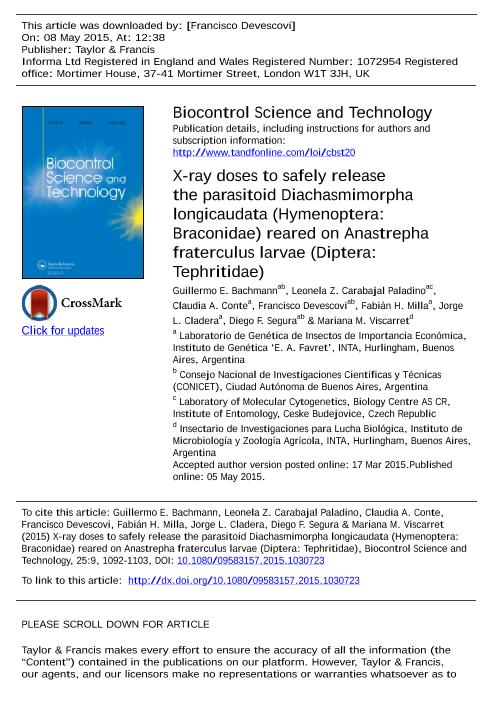Artículo
X-ray doses to safely release the parasitoid Diachasmimorpha longicaudata (Hymenoptera: Braconidae) reared on Anastrepha fraterculus larvae (Diptera: Tephritidae)
Bachmann, Guillermo Enrique ; Carabajal Paladino, Leonela Zusel
; Carabajal Paladino, Leonela Zusel ; Conte, Claudia Alejandra
; Conte, Claudia Alejandra ; Devescovi, Francisco
; Devescovi, Francisco ; Milla, Fabian Horacio; Cladera, Jorge Luis; Segura, Diego Fernando
; Milla, Fabian Horacio; Cladera, Jorge Luis; Segura, Diego Fernando ; Viscarret, Mariana Mabel
; Viscarret, Mariana Mabel
 ; Carabajal Paladino, Leonela Zusel
; Carabajal Paladino, Leonela Zusel ; Conte, Claudia Alejandra
; Conte, Claudia Alejandra ; Devescovi, Francisco
; Devescovi, Francisco ; Milla, Fabian Horacio; Cladera, Jorge Luis; Segura, Diego Fernando
; Milla, Fabian Horacio; Cladera, Jorge Luis; Segura, Diego Fernando ; Viscarret, Mariana Mabel
; Viscarret, Mariana Mabel
Fecha de publicación:
05/2015
Editorial:
Taylor & Francis Ltd
Revista:
Biocontrol Science and Technology
ISSN:
0958-3157
Idioma:
Inglés
Tipo de recurso:
Artículo publicado
Clasificación temática:
Resumen
Diachasmimorpha longicaudata is a koinobiont larval parasitoid that is currently used to control fruit flies of the genera Anastrepha, Ceratitis and Bactrocera. In the rearing process, a fraction of the host larvae that are exposed to parasitoids escape from parasitism and develop into viable and fertile flies. This creates the need to eliminate emerging flies before the parasitoids are shipped for release, increasing costs due to additional handling steps. Exposure of fly eggs or larvae to gamma-irradiation before they are parasitised has been used to reproductively sterilise hosts, or even inhibit their emergence. Our aim was to determine whether X-ray radiation applied to Anastrepha fraterculus third instar larvae before they are exposed to parasitoids, inhibits fly emergence in non-parasitised larvae without affecting the performance of the parasitoids that emerge from parasitised larvae. Three X-ray doses: 6250.2 R, 8333.6 R and 10417 R (equivalent to 60, 80 and 100 Gy, respectively) and one γ-ray dose (100 Gy) were tested. Fly emergence decreased with increasing doses of radiation, showing null values for the higher X-ray dose and the dose of 100 Gy. Irradiation showed either no impact or a positive effect on parasitism rate and fecundity. Sex rate was biased towards females in almost every dose. We conclude that the two types of radiation evaluated here were equally effective in suppressing fly emergence with no detrimental effects on the biological quality of the produced parasitoids. X-rays offer an alternative method of irradiation than the conventional radiation source, i.e. γ-rays. These results represent a significant improvement in the development of a biological control programme against A. fraterculus.
Archivos asociados
Licencia
Identificadores
Colecciones
Articulos(SEDE CENTRAL)
Articulos de SEDE CENTRAL
Articulos de SEDE CENTRAL
Citación
Bachmann, Guillermo Enrique; Carabajal Paladino, Leonela Zusel; Conte, Claudia Alejandra; Devescovi, Francisco; Milla, Fabian Horacio; et al.; X-ray doses to safely release the parasitoid Diachasmimorpha longicaudata (Hymenoptera: Braconidae) reared on Anastrepha fraterculus larvae (Diptera: Tephritidae); Taylor & Francis Ltd; Biocontrol Science and Technology; 25; 9; 5-2015; 1092-1103
Compartir
Altmétricas



